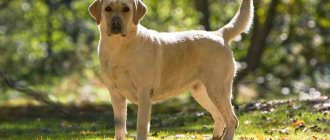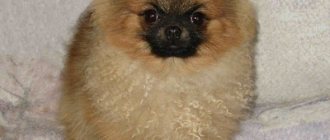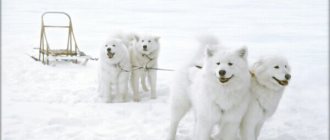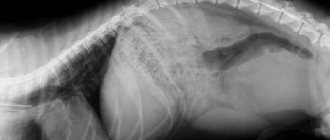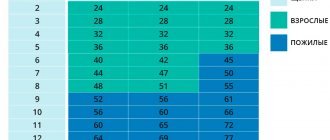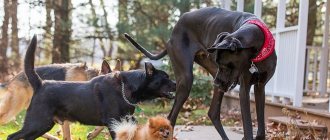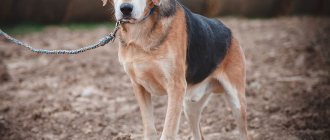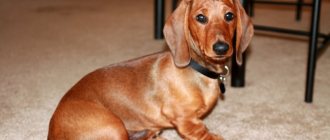Dachshund diseases are best diagnosed by veterinarians, but owners may be the first to spot the problem and bring the dog to the doctor. As soon as there is a suspicion of illness, any responsible owner should drop his business and take the dog to the veterinary hospital.
We can exclude known diseases in dachshunds, knowing the symptoms of the disease, or cure them in a short time. We can take care of dachshunds, keep them healthy with vaccinations, proper nutrition, education and walks. Let's learn in detail about the health of Dachshund dogs, what diseases it can suffer from and how to cope with them.
Spine and bone problems
The elongated body suggests a non-standard structure of the spine. Therefore, the dachshund's back is always supported by moderate physical activity.
Experts advise against going up and down stairs for up to 7-8 months, jumping from great heights, and sitting in an upright position.
The main and common problem of dachshunds is discopathy. The vertebrae may move out of place, and the cartilage may stretch or become thinner. Then the dog shows the following signs:
- Anxiety;
- Painful sensations with light pressure on the back;
- Hind limb failure;
- Involuntary urination.
Discopathy is treated therapeutically in simple cases and when detected quickly. Massages and medications are prescribed.
In case of severe symptoms of the disease, surgical intervention cannot be avoided. The diagnosis is made on the basis of studies, including x-rays.
Dachshund puppies suffer from swimmer's syndrome. Already in the first weeks after birth, this disease manifests itself as follows:
- It is difficult for the puppy to roll over;
- Limbs come apart when trying to stand on them;
- Flattening of the chest.
If the diagnosis is made early, the disease can be easily overcome with vitamin and mineral supplements. Also, puppies are regularly examined after birth and their movements are observed.
Sometimes swimmer's syndrome goes away on its own, but in severe cases the dog is euthanized. Swimming in warm water and walking with support additionally helps to cope with a protracted illness.
How to determine age?
It is unlikely that it will be possible to determine the exact age of an animal if there is no birth certificate or veterinary passport that records the date of its birth.
But you can roughly say how old a dachshund is based on the following signs::
- Gray hair . It begins to appear after 7 years of age in the area of the lips and chin in dogs. If a dachshund’s entire muzzle and forehead turns gray, then it means that it can already be considered elderly and is no less than 9 years old.
- Condition of the coat . In older dogs it looks duller and more disheveled, while in young dachshunds, even wirehaired ones, it is smoother and shinier.
- Eyes . In older dogs, they seem to sink in and appear to be more deeply set.
- Condition of teeth . One-year-old dogs' teeth are smooth, white and shiny, but already at the age of 18 to 24 months, the lower toes begin to wear off. At 2.5 years, abrasion also affects the lower incisors, and the teeth themselves become less dazzling white. By the age of five, the fangs begin to wear out and become dull, and by the age of six they turn a little yellow and become covered with tartar underneath. By the age of 7-8 years, the fangs look yellow and very blunt. Also, the fact that the dachshund is already 7 years old may be indicated by the fact that the lower toes have acquired a reverse oval shape. If this also happened to the lower incisors, then the dog is at least 8-9 years old. And the reverse-oval shape of the upper hooks indicates that the animal is 9-10 years old.
At 10-12 years old, the dachshund's teeth begin to fall out, and hearing and vision may also deteriorate..
Dachshund skeleton
The dachshund skeleton consists of the skull, lower jaw, scapula, humerus, radius, carpus, ulna, metacarpus, tibia, tarsus, metatarsus, hip, fibula, sternum, patella (patella), phalanx, cervical, thoracic, lumbar, sacral, caudal vertebrae and calcaneal tubercle.
Skin problems
The most common of these in dachshunds and all dogs are fleas and demodicosis. The first parasites are removed by drops and washing. All products are selected according to the age and weight of the dog.
Be sure to carry out prevention every 3 months with drops on the withers, sprays against fleas and ticks. Shampoos for dogs are used medicinal.
Demodicosis in chronic and generalized form is treated under the supervision of a doctor. In the acute phase, powerful drugs that destroy subcutaneous mites help.
However, they can negatively affect the liver and other organs, so maintenance medications are prescribed.
Acanthosis nigricans is a rather exotic disease for other breeds. It occurs most often in dachshunds. Signs:
Important: These products should not be applied to the dog’s skin immediately after washing. You must wait 3-4 days, otherwise the substances will not work and irritation may occur.
- Local and severe baldness;
- Thickening of the skin and the appearance of folds in these places;
- Unpleasant odor;
- Change in skin color.
The disease affects areas of skin under the arms and in the groin. For treatment, hormonal ointments, care products with birch tar, antihistamines, and moisturizing creams are used.
Acanthosis nigricans takes a long time to treat and most often becomes chronic. A diet that alleviates the course of the disease is also important.
Important: Dogs with a generalized form of demodicosis and acanthosis nigricans are not allowed for breeding.
Allergic reactions do occur in dachshunds, but not all of them. They get rid of the problem by choosing a safe diet. Potential allergens that try to exclude at the first signs (itching, redness, baldness, swelling):
- Chicken;
- Vegetables;
- Corn;
- Cereals.
If the dog is feeling unwell, they are given medications to eliminate allergy symptoms. However, to identify the cause, you need to look at the reaction to certain foods. Allergens are excluded from the dachshund menu forever.
Main breed diseases in dachshunds
As mentioned above, this breed of dog is endowed with excellent health, but they have their own diseases, including:
Kidney disease
If you suspect problems with the kidneys or urination, you should immediately contact your veterinarian. The presence of a disease in a dachshund is symbolized by the following signs:
- increased water consumption combined with frequent or infrequent and usually painful urination, the presence of a blood clot is possible;
- loss of appetite and, as a result, loss of body weight;
- bad breath;
- digestive tract disorder;
- impaired coordination of movements;
- swelling of the limbs;
- changes in visual function;
- lethargy and constant sleep.
Dogs are most often diagnosed with:
- nephritis (inflammatory kidney disease caused by harmful microorganisms, poisoning or mechanical damage);
- glomerulonephritis;
- pyelonephritis;
- nephrosis (disturbs the metabolic process and reduces renal function, can be caused by bacteria, chronic diseases or congenital dysfunction);
- nephrosclerosis (structural change, as a result of which the kidneys decrease in size, losing their normal shape);
- polycystic disease (diagnosed by identifying many cysts in an organ, which may be congenital, but do not manifest themselves until a certain time);
- acute/chronic renal failure (rapid/gradual loss of functionality, requires emergency medical care).
Acanthosis nigricans
It manifests itself as local baldness, the formation of pigmentation throughout the body, the appearance of folds uncharacteristic of the normal state, which are accompanied by an unpleasant odor. This leather is very similar to ivory. There is no single source of this disease. Genetic predisposition may play a role here if the dachshund's parents had a similar problem.
Also provoking factors may be allergic reactions, hormonal fluctuations, metabolic disorders and stressful situations. Treatment of acanthosis nigricans is successfully carried out in a veterinary clinic. It is worth noting that a dog that has suffered from this disease is not allowed to reproduce.
Spinal diseases
Discopathy is displacement and deformation of the intervertebral discs, as a result of which the tissue loses its elasticity. The dachshund's vertebrae may be in an unnatural position, twisting and moving apart, and the internal contents enter the spinal cord, compressing the nerve roots.
In an advanced stage, the disease can lead to partial/complete paralysis of the paws. Symptoms: the dog has difficulty moving, ceases to be active, and a hump grows on the back, painful for the dachshund when touched. Timely treatment of discopathy guarantees prompt recovery, but for each dachshund it takes place individually - from 2 weeks to several years.
Spondylosis affects dogs over 7 years of age. This is ossification of the intervertebral discs, which pinches the nerve roots. The outcome may be the same as in the case of discopathy. Physiotherapeutic procedures and medications are usually used to treat the disease in dachshunds.
Osteochondrosis. The danger of the disease in an advanced state is the failure of the hind legs. You can suspect a problem in a dachshund by the following symptoms: when moving, the dog drags its hind limbs, leaning on its front legs with its chest raised high. Also characteristic is an unnatural position when sitting, pain when changing position, which is reflected in the voice. Rehabilitation therapy involves the prescription of drugs that increase blood circulation in problem areas, massage and physiotherapy.
Paw diseases
Osteoporosis - the dachshund is diagnosed with locomotion on its stomach because coordination of movements on all legs is impaired. This affects small puppies under 3 months of age. This is due to the fragility of bones and joints. In this case, drug treatment and nutritional correction with the inclusion of vitamin supplements are indicated.
Foot diseases
Articular dysplasia is partial/complete destruction of tissue. This disease is rare for Dachshund dogs. Most often it has hereditary roots and can occur in a latent form until a certain point.
Arthritis/arthrosis causes considerable discomfort to the dog. It is expressed in the form of pain in the paws and appears as a result of a lack of balance and proper diet.
Heart diseases
They are divided into congenital and acquired. Congenital, as a rule, begin to appear in adolescence and are associated with the heart valves and blood vessels.
This problem in dogs is characterized by irregular heartbeat, shortness of breath, discoloration of the tongue, and fainting. acquired ones lead to thickening and deformation of the valves, which can cause the development of heart failure. When visiting a veterinary clinic, the doctor issues a referral for echocardiography and electrocardiogram.
Eye diseases
Glaucoma is a dangerous disease of dogs caused by a violation of the outflow of liquid contents, resulting in increased pressure that destroys the retina and causes ischemia. Symptoms of glaucoma: unbearable pain in the eyes, frequent blinking of the dog, changes in the position of the lens, constant discharge of fluid from the eyes of the dachshund, blurred vision.
Ear diseases
Otodectosis. It is caused by ear mites that feed on hair follicles and cause great discomfort to the dog. It is accompanied by itching, the appearance of a rough crust and discharge.
Otitis. It has similar symptoms to otodectosis. The only cause of its occurrence is an allergic reaction. In this case, it is recommended to review the dachshund’s diet and eliminate foods that cause food intolerance.
A hematoma is an injury that can damage a blood vessel. Its danger is that swelling occurs and visually looks like a lump that is hot to the touch. If the hematoma is small, it will resolve on its own.
Obesity
This is the real scourge of the dachshund. Owners very often overfeed their dog when there is no physical activity. The dog begins to rapidly gain weight, and this can shorten its life expectancy. In order to prevent weight gain, it is necessary to adhere to the developed diet and walk the dog more often to meet its needs. However, in addition to banal overfeeding, there are also deeper reasons, including the presence of chronic diseases.
False pregnancy
This often occurs in dachshunds and occurs against the background of hormonal fluctuations. In other words, during puberty, the release of hormones necessary for successful mating and the normal course of pregnancy is activated. If the mating was unsuccessful and a real pregnancy did not occur, then the hormonal surge does not end; in fact, the body begins to prepare for childbirth, which will not happen.
Not a single dog is immune from this: the phenomenon can occur in both young and giving birth dachshunds. Symptoms of a false pregnancy resemble real ones: the dog’s appetite increases, its mood changes, and it tends to be alone. This condition lasts about 3 months and usually does not cause concern.
Epilepsy
The disease diagnosed in a dog of this breed is associated with a malfunction in the central nervous system and is manifested by a sharp drop in the dachshund with characteristic body movements, breathing is interrupted, and the pulse quickens. The epileptic state lasts for several minutes, after which the dog simply gets up and does not understand what happened.
Disease prevention
Taking preventative measures will help keep your friend healthy. A visit to the veterinary clinic is recommended twice a year for a preventive examination of your dachshund by specialists for:
- examination of the oral cavity;
- orthopedic examination;
- eye pressure control;
- neurological research.
Attentive attitude towards your pet will allow you to take timely measures to make a diagnosis and provide timely medical care. At home, you should regularly carry out hygiene procedures:
- ear cleaning;
- care of teeth, fur, claws.
Eyes should be wiped with a cotton swab dipped in warm tea leaves; when cleaning the ears, you can use a weak solution of hydrogen peroxide.
Vaccinations: when and which ones to give?
- The first vaccination for a dachshund puppy is carried out no earlier than it reaches 1.5 months of age. Complex vaccination is carried out against:
- plague;
- adenovirus;
- hepatitis A;
- enteritis;
- After 2 weeks, revaccination is performed with the same composition.
- At 6 months, vaccination is repeated with the addition of a vaccine against leptospirosis.
- At 1 year old, the dachshund is vaccinated against rabies and infectious diseases.
- Every subsequent year of life, the dachshund should be vaccinated against rabies or use a complex vaccine that includes other infections.
Two weeks before the expected date of vaccination, the pet should be dewormed. Only healthy dogs should be vaccinated.
Healthy lifestyle
The dachshund is an active and courageous dog, it is playful and friendly, paying attention and providing long walks to the pet, the breeder will receive a devoted friend. Proper maintenance, feeding and walking of the dachshund is important for the health and well-being of the pet.
Watch your diet, avoiding overfeeding leading to obesity. During walks, do not allow your pet to jump from great heights to avoid unnecessary stress on the spine.
Important ! Never lift your dachshund by its front legs or scruff.
Caring attention and proper care of your dachshund will allow you to enjoy the company of a faithful friend for many years, since representatives of this breed are long-livers.
Caring for an older dog
An older dachshund needs the attention and care of its owner more than in its younger years. Many dogs already have difficulty seeing and hearing, and therefore they should only be taken for walks on a leash.
In addition, it is necessary to carefully protect an elderly pet from drafts, and in cold weather, dress him in a blanket, sweater or overalls, even if he previously managed well without clothes.
In general, caring for an older dog remains the same and includes brushing, cleaning eyes, ears and teeth, as well as trimming nails..
But you should not bathe an older dog unless necessary: there is a very high risk that it will catch a cold.
IMPORTANT!
It is recommended to take your elderly pet to the veterinary clinic for preventive examinations at least once a year.
With good living conditions and quality care, dachshunds can live much longer than most other dog breeds - up to 17 years or more.
You also need to understand that poor quality nutrition or improper living conditions for a pet lead to many diseases that significantly shorten its life.
But even if the dog is provided with the best of all possible conditions, we must not forget that a dachshund, living in a family, should feel love and care from its owners from the first day of its arrival in the house until the last minutes of its life.
And that it is the attentive and responsible attitude of the owner towards the pet that is the main factor that allows the dachshund to live long and happily.
Ears and eyes
Ear problems in dachshunds most often lead to otodectosis. Ear mites and their waste products irritate delicate skin and cause copious dark-colored discharge with an unpleasant odor.
Crusts also appear in the ears, and the dog constantly shakes his head and tries to scratch them. Treatment for ear mites involves the use of parasite medications and sometimes antibiotics.
Some dachshunds have an anomaly - double eyelashes or their abnormal growth. Then the mucous membrane and the eye are damaged. The inflammation is relieved and the situation is usually corrected surgically.
Diagnostic methods
In modern veterinary medicine, there are several methods for diagnosing discopathy:
- Visual inspection . At the same time, the veterinarian evaluates the dog’s skills: walking, jumping, reflex speed, presence of pain, etc.
- If the dog partially or completely lacks sensitivity in the limbs, the doctor assesses the time of onset of paralysis . It is believed that if more than 12 hours have passed since the moment of immobility, then it is no longer possible to restore the function of bowel movements, since it is impossible to restore the function of neurons.
- X-ray studies . In this case, an x-ray allows you to detect changes in the spine, exclude diseases of the vertebrae, and also allows you to detect the presence of injuries.
- MRI (magnetic resonance imaging) allows you to see an accurate and complete picture of the condition of the dog’s spine. The study is done layer by layer in a three-dimensional projection, which makes it possible to understand the picture of the disease as a whole. During the MRI, the animal is under the influence of sedatives.
- Myelography is a research method in which a contrast agent is injected under the arachnoid membrane of the dog's spinal cord, and then an X-ray examination is performed.
Signs of feeling unwell
To contact a veterinarian, it is enough to detect the following signs in your dachshund:
- Restless behavior, fussiness;
- Pressing the hind legs towards the stomach in a lying position;
- The dog constantly bends its back (“cupolite”);
- Stomach upset;
- Increased body temperature – above 38.5 degrees;
- Constantly low body temperature – below 37.5 degrees;
- Vomit;
- Pale mucous membranes;
- Baldness;
- Bad breath;
- Refusal to eat for 2 days.
An upset stomach is a symptom of a large number of diseases. Only a veterinarian can determine the cause.
Important: You should not allow your dachshund to be overweight. Obesity has a detrimental effect on the cardiovascular system and liver, which can cause the back to sag and discopathy to appear, the legs to weaken, shortness of breath and poor functioning of internal organs.
Discopathy
The most common disease of dachshunds is discopathy, the so-called “causeless paralysis.”
The first symptoms of the disease are:
- increased anxiety,
- fatigue, irritability;
- pain in the back and abdomen;
- after some time the dog does not rise on its hind legs;
- urination becomes an uncontrollable process.
If you notice the first symptoms or unusual behavior of your pet, you should definitely consult a specialist. It is difficult to say for sure why the spine of a healthy animal can instantly suffer.
Drug treatment
At the initial stage of the disease, drug treatment is allowed, which helps relieve symptoms, but does not cure the disease.
For conservative treatment of discoptia, the veterinarian prescribes:
- Corticosteroid hormones.
- Vitamin "B" injections.
- Non-steroidal anti-inflammatory drugs such as Rimadyl, Previcox, Ketofen.
- Painkillers.
- Chondroprotectors to maintain cartilage structure, such as Flexan. Such substances contain bioactive collagen molecules, which slow down degenerative processes in the spine.
- Drugs that relieve inflammation, for example, Canina Petvital Frnhro tabletttn. Such drugs help to establish balance in the inert tissue and increase the elasticity of the ligaments, which bear additional stress due to the loss of functionality of the spinal disc.
Obesity
This is a real scourge of the breed. Created for hunting, for a life full of activity, the city dachshund often finds itself in a situation where its instincts remain unfulfilled. As a result, bulimia becomes second nature for the dog. In this place we could show shocking photos of animals in the final stages of obesity, but we will not do this: there is no desire to spread negativity.
In any case, we advise you to read the article about the character of the modern dachshund, the characteristics of this breed and what it needs.
There are not so many specific diseases in dachshunds, and all of them are treatable or can be easily prevented by proper feeding and maintenance.
With all our hearts we wish all dogs good health and love!
If you are not yet sure about the breed you want to get, please
Vulnerable spine
Dachshund owners most often turn to a veterinarian because of problems with their pet’s spine. This is not surprising, since representatives of this hunting breed suffer from diseases such as intervertebral hernia and displaced discs. This is especially true for dachshunds whose age has passed the five-year mark. The development of diseases of the musculoskeletal system is explained by the skeletal characteristics of representatives of this breed. Firstly, the dachshund has a long body and disproportionately short legs, which is why the spine is constantly subject to significant stress. Secondly, a dog of this breed is prone to obesity, and the extra pounds gained create additional stress on the musculoskeletal system, which provokes problems with the spine.
What symptoms on the part of the dog should alert the owner:
- when intervertebral discs become displaced, the dachshund becomes inactive and lies on its side most of the time;
- when walking, the animal's back is hunched;
- spontaneous urination is observed;
- the dog refuses food and water because the discomfort causes it to lose its appetite.
When the spinal disease is advanced, the dachshund's limbs become paralyzed, causing the animal to limp severely or completely lose mobility. This condition requires immediate assistance from a specialist, since paralysis quickly provokes complications leading to death.
Treatment tactics for spinal diseases depend on the severity of the disease. If the dog has not lost mobility, then they are limited to conservative treatment prescribed by the veterinarian. If the limbs are paralyzed, surgery may be prescribed.
The prognosis of spinal diseases in dachshunds depends on the timeliness of treatment. The sooner the necessary measures were taken, the better the prognosis.
Epilepsy
Idiopathic epilepsy is relatively often observed in long-haired dachshunds, as a consequence of a congenital anomaly of the nervous system.
Before attacks, the dog becomes very anxious, does not respond to external stimuli, the head muscles twitch, and the gait becomes unsteady. Immediately after this, the animal loses consciousness, convulsions appear, and breathing is hoarse. The duration of the attack is from several seconds to an hour. After an attack, the dachshund is disoriented, does not recognize its owners and is in prostration.
Epilepsy is treated with sedatives, most often phenobarbital.
Please do not despair if you have been diagnosed with this! With high-quality therapy, the pet is guaranteed a long and high-quality life.
Osteoporosis in puppies
The second breed disease is osteoporosis, or swimmer's syndrome. The disease occurs in many dogs, but in the case of dachshunds, the disease is recorded much more often: puppies as young as one month are affected.
Lack of sufficient amounts of minerals and vitamins (in particular D) in the diet, and rare walks in the sun are predisposing factors for the disease.
The characteristic symptoms of the disease are a floating gait: the paws move apart and the puppy has to walk on its stomach.
With proper treatment, the disease quickly regresses, the bones are restored, and the pet does not face disability.
Again, the disease can be avoided by proper feeding, in which the ratio of calcium and phosphorus is balanced. It is important to find a middle ground when creating a diet: overfeeding contributes to obesity, while overweight puppies have a very high chance of developing the syndrome.
Main causes of premature death
Dachshunds can be predisposed to a number of diseases:
- Chest deformity.
- Slipped disc syndrome leading to paralysis.
- Epilepsy.
- Progressive retinal atrophy.
- Anomalies of eye development.
Most of them do not lead to the death of the dog . But due to the fact that the dachshund loses the ability to move, see, or due to more frequent seizures, in some cases, owners have to euthanize the pet to save it from suffering.
In older dachshunds, a chronic disease that had previously occurred in a latent form may suddenly worsen, which is also often the reason that a pet that could have lived for quite a long time suddenly dies at the age of 8-10 years.
Accidents or injuries are also a common cause of premature death in dachshunds..
Moreover, often this happens because the owner himself caused an accident due to inattention. And deliberate disregard for safety almost always leads to tragic consequences for the pet.
This happens, for example, when the owner, wanting to show off the dog’s excellent training, takes it for a walk on a street without a leash where there are a lot of cars.
CAREFULLY!
Many dogs die due to poisoning, such as from eating a poisoned rodent or licking a surface treated with a chemical.
Therefore, you need to be careful when using pesticides in everyday life: do not throw them where the pet can get them, and while the surfaces are being treated, the dog must be removed from the room.
Poisoning rodents if you have a dachshund in the house is not recommended: it is better to try to get rid of mice or rats in another way that is safe for your pet..
Acanthosis nigricans - skin dystrophy
Sweets are not good for the dachshund.
Another purely “dachshund” disease, which, if it affects other breeds, occurs only in isolated cases. Dachshund skin with this disease looks horrifying: in the armpits, thighs, chest and abdomen there is increased pigmentation, hair loss and the formation of thick, hanging folds, all of which is complemented by a fetid odor.
It is difficult to say what causes the appearance of “elephant skin”. Some believe that acanthosis is a genetic disease; others are a consequence of frequent diathesis, ultimately leading to a radical change in hormonal levels and metabolic disorders; still others directly link the sore to diabetes and hypothyroidism. Stress can be the impetus for development. And one more point that has been repeated more than once: obesity provokes pathology!
It is quite difficult to predict the outcome, the main thing is not to give up. The pet is prescribed corticosteroids, the skin is treated with special ointments and shampoos containing sulfur, tar and vitamin A preparations. There are and will be cases of complete recovery!
Prevention - preventing animals suffering from or predisposed to acnatosis from breeding, using the right hypoallergenic food and no handouts in the form of chocolates and other harmful things between feedings.
